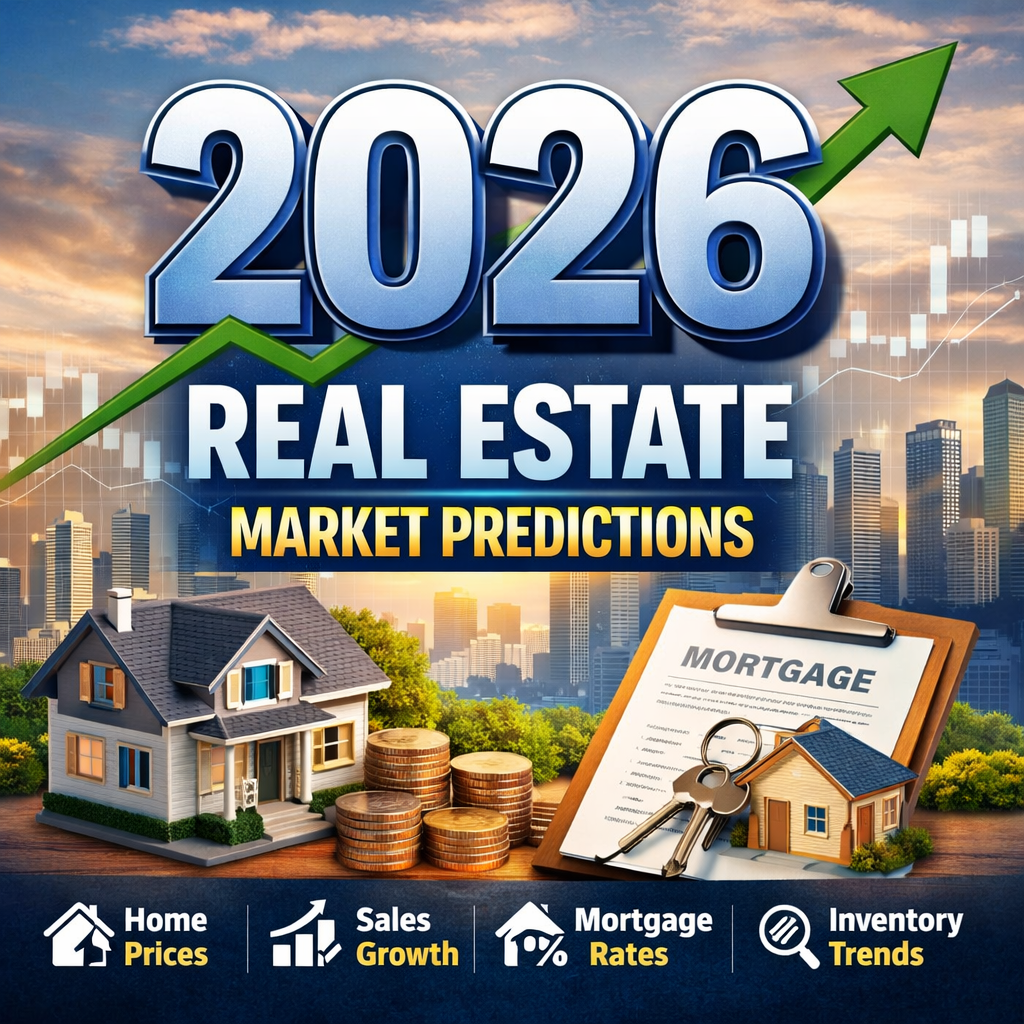What are the real estate trends for 2025 and 2026?
Here’s a comprehensive outlook on U.S. real estate trends for 2025–2026, based on the latest expert forecasts, news, and market signals:
🏠 Residential Market (2025–2026)
Home Sales & Prices
-
The National Association of Realtors (NAR) projects a 9 % rise in home sales in 2025 and about 13 % growth in 2026, assuming mortgage rates stabilize near 6 % Wikipedia+7Reddit+7cbre.com+7Reddit+2Norada Real Estate+2Norada Real Estate+2.
-
However, Capital Economics forecasts more modest growth: around 4 % annually through 2025–2026, with rates around 7 % in 2025, gradually easing to 6 % by end‑2026 Business Insider.
-
Bank of America predicts only ~2 % home price growth in 2025, slower than earlier estimates due to rising inventory and affordability issues Reddit.
-
Others expect HPI increases around 2–3 % in 2025, possibly accelerating to 3–4 % in 2026, though potential rate cuts could trigger modest rebounds (5 % nominal dips in adverse scenarios) jpmorgan.com+6marketwatch.com+6Reddit+6.
Mortgage Rates & Buyer Sentiment
-
Rates are likely to hover between 6 %–7 %, with a key psychological threshold at 6 %, which could unlock significant buying interest nypost.comBusiness Insider.
-
First-time and younger buyers are increasingly favoring rental over ownership due to poor affordability, while affluent purchasers, including foreign buyers paying in cash (~44 % increase in 2025), continue to put upward pressure on prices in higher-end segments Business Insider+1investopedia.com+1.
Inventory & Regional Variation
-
Inventory remains below pre‑pandemic norm in many markets but is slowly recovering, particularly in markets with new construction or changing taxes/insurance burdens (e.g. Austin, Tampa) Reddit+1Reddit+1.
-
Regional disparities: major slowdowns in Sun Belt and Western metros (e.g. Tampa, Boise), contrasting strong year-over-year gains in Midwestern cities like New York, Chicago, Detroit, Toledo, Akron barrons.com.
-
Sun Belt suburbs like Phoenix, Miami, and parts of Georgia face zoning restrictions limiting multi-family housing, intensifying supply constraints and price rise vox.com.
🏢 Commercial & Multifamily Real Estate
Office & Retail
-
Office demand is recovering in prime urban cores; vacancy remains bifurcated, with strong performance in high-end locations and persistent distress in older, secondary assets cbre.com.
-
Retail is experiencing increasing demand in Sun Belt and suburban areas, with retail vacancy among lowest across sectors and institutional capital returning cbre.comcbre.com.
Industrial & Logistics
-
Industrial leasing remains buoyed by e‑commerce, though there’s a pronounced “flight-to-quality”, with older properties losing favor and vacancy gradually tightening cbre.com.
Multifamily Rentals
-
High ownership costs continue to fuel rental demand, supporting stable rent growth across markets with constrained supply, though new construction may soften tightness in select markets later in the period cbre.comRedditcbre.com.
Investment & Emerging Drivers
-
Commercial real estate investment activity is expected to rise ~10 % in 2025, though still below pre‑pandemic levels; cap rates may compress slowly cbre.com.
-
Growing urgency around climate resilience, energy retrofits, and cybersecurity risk management are reshaping CRE priorities jpmorgan.com.
-
Affordable housing, modular construction, and proactive public–private partnerships are seen as key growth avenues jpmorgan.comCRE Daily.
🧾 Technology & Structural Shift
-
Proptech adoption continues expanding into AI‑driven analytics, blockchain-enabled rentals and tokenization, smart contracts, and better digital customer experiences Reddit.
-
Smart buildings, green certifications, and ESG compliance are increasingly central to both investor demand and regulatory frameworks Reddit+1Reddit+1.
✅ Summary Table
| Trend | 2025 Outlook | 2026 Outlook |
|---|---|---|
| Home Sales | +4–9 % | +11–13 % |
| Home Prices National Avg | +2–4 % | Similar to modest uptick continued |
| Mortgage Rates | ~6–7 % | Possible drop toward ~6 % |
| Rental Demand | Strong, due to high ownership costs | Continues firm |
| CRE Sectors | Office recovery, industrial strong | Retail and multifamily stable/growing |
| Tech & ESG | Growing integration | Becomes more mainstream |
🔍 What to Watch
-
Interest Rate Trajectory: Key catalyst for affordability and demand.
-
Regional nuances: For instance, Atlanta’s suburbs face rising demand and tighter supply; insurance costs may stress coastal markets.
-
Policy & zoning changes: YIMBY reforms, affordable housing incentives, and ESG mandates may unlock new development patterns.
-
Climate and risk metrics: Capital may shift away from high-risk zones; resilience planning becomes central to valuation.
Overall, while homeownership remains out of reach for many due to affordability pressures, cautious optimism prevails: stabilizing or easing rates, improving supply, and solid rental demand should support a gradual housing market rebound into 2026, even if fast growth remains unlikely. Commercial real estate is quietly stabilizing, with industrial, multifamily, and ESG-aligned assets emerging as preferred plays.








